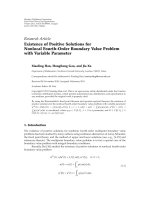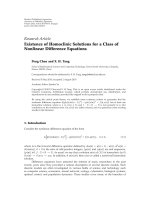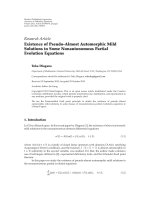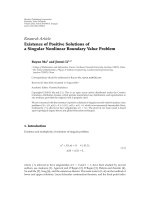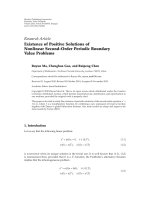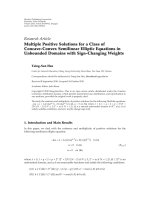báo cáo hóa học:" Research Article Existence of Solutions to a Nonlocal Boundary Value Problem with Nonlinear Growth" pptx
Bạn đang xem bản rút gọn của tài liệu. Xem và tải ngay bản đầy đủ của tài liệu tại đây (520.3 KB, 15 trang )
Hindawi Publishing Corporation
Boundary Value Problems
Volume 2011, Article ID 416416, 15 pages
doi:10.1155/2011/416416
Research Article
Existence of Solutions to a Nonlocal Boundary
Value Problem with Nonlinear Growth
Xiaojie Lin
School of Mathematical Sciences, Xuzhou Normal University, Xuzhou, Jiangsu 221116, China
Correspondence should be addressed to Xiaojie Lin,
Received 17 July 2010; Accepted 17 October 2010
Academic Editor: Feliz Manuel Minh
´
os
Copyright q 2011 Xiaojie Lin. This is an open access article distributed under the Creative
Commons Attribution License, which permits unrestricted use, distribution, and reproduction in
any medium, provided the original work is properly cited.
This paper deals w ith the e xistence of solutions for the following differential equation: x
t
ft, xt,x
t, t ∈ 0, 1, subject to the boundary conditions: x0αxξ, x
1
1
0
x
sdgs,
where α ≥ 0, 0 <ξ<1, f : 0, 1 × R
2
→ R is a continuous function, g : 0, 1 → 0, ∞ is a
nondecreasing function with g00. Under the resonance condition g11, some existence
results are given for t he boundary value problems. Our method is based upon the coincidence
degree theory of Mawhin. We also give an example to illustrate our results.
1. Introduction
In this paper, we consider the following second-order differential equation:
x
t
f
t, x
t
,x
t
,t∈
0, 1
, 1.1
subject to the boundary conditions:
x
0
αx
ξ
,x
1
1
0
x
s
dg
s
,
1.2
where α ≥ 0, 0 <ξ<1, f : 0, 1 × R
2
→ R is a continuous function, g : 0, 1 → 0, ∞ is a
nondecreasing function with g00. In boundary conditions 1.2, the integral is meant in
the Riemann-Stieltjes sense.
2 Boundary Value Problems
We say that BVP 1.1, 1.2 is a problem at resonance, if the linear equation
x
t
0,t∈
0, 1
, 1.3
with the boundary condition 1.2 has nontrivial solutions. Otherwise, we call them a
problem at nonresonance.
Nonlocal boundary value problems were first considered by Bicadze and Samarski
˘
ı
1 and later by Il’pin and Moiseev 2, 3. In a recent paper 4, Karakostas and Tsamatos
studied the following nonlocal boundary value problem:
x
t
q
t
f
x
t
,x
t
0,t∈
0, 1
,
x
0
0,x
1
1
0
x
s
dg
s
.
1.4
Under the condition 0 g0 ≤ g1 < 1 i.e., nonresonance case, they used Krasnosel’skii’s
fixed point theorem to show that the operator equation x Ax has at least one fixed point,
where operator A is de fined by
Ax
t
t
1 − g
1
1
0
1
s
q
r
f
x
r
,x
r
dr dg
s
t
0
1
s
q
r
f
x
r
,x
r
dr ds.
1.5
However, if g11 i.e., resonance case, then the method in 4 is not valid.
As special case of nonlocal boundary value problems, multipoint boundary value
problems at resonance case have been studied by some authors 5–11.
The purpose of this paper is to study the existence of solutions for nonlocal BVP 1.1,
1.2 at resonance c ase i.e., g11 and establish some existence results under nonlinear
growth restriction of f. Our method is based upon the coincidence degree theory of Mawhin
12.
2. Main Results
We first recall some notation, and an abstract existence result.
Let Y , Z be real Banach spaces, let L :domL ⊂ Y → Z bealinearoperatorwhich
is Fredholm map of index zero i.e., Im L,theimageofL,KerL,thekernelofL are finite
dimensional w ith the same dimension as the Z/ Im L,andletP : Y → Y, Q : Z → Z
be continuous projectors such that Im P Ker L,KerQ Im L and Y Ker L ⊕ Ker P, Z
Im L ⊕ Im Q. It follows that L|
dom L∩Ker P
:domL ∩ Ker P → Im L is invertible; we denote
the inverse by K
P
.LetΩ be an open bounded, subset of Y such that dom L ∩ Ω
/
∅,themap
N : Y → Z is said to be L-compact on
Ω if QNΩ is bounded, and K
P
I − QN : Ω → Y is
compact. Let J :ImQ → Ker L be a linear isomorphism.
The theorem we use in the following is Theorem IV.13 of 12.
Boundary Value Problems 3
Theorem 2.1. Let L be a Fredholm operator of index zero, and let N be L-compact on
Ω. Assume that
the following conditions are satisfied:
i Lx
/
λNx for every x, λ ∈ dom L \ Ker L ∩ ∂Ω × 0, 1,
ii Nx
/
∈ Im L for every x ∈ Ker L ∩ ∂Ω,
iii degJQN|
Ker L
, Ω ∩ Ker L, 0
/
0,
where Q : Z → Z is a projection with Im L Ker Q. Then the equation Lx Nx has at least one
solution in dom L ∩
Ω.
For x ∈ C
1
0, 1,weusethenormsx
∞
max
t∈0,1
|xt| and x max{x
∞
, x
∞
}
and denote the norm in L
1
0, 1 by ·
1
. We will use the Sobolev space W
2,1
0, 1 which may be
defined by
W
2,1
0, 1
x :
0, 1
−→ R | x, x
are absolutely continuous on
0, 1
with x
∈ L
1
0, 1
.
2.1
Let Y C
1
0, 1, Z L
1
0, 1. L :domL ⊂ Y → Z is a linear operator defined by
Lx x
,x∈ dom L, 2.2
where
dom L
x ∈ W
2,1
0, 1
: x
0
αx
ξ
,x
1
1
0
x
s
dg
s
. 2.3
Let N : Y → Z be defined as
Nx f
t, x
t
,x
t
,t∈
0, 1
. 2.4
Then BVP 1.1, 1.2 is Lx Nx.
We will establish existence theorems for BVP 1.1, 1.2 in the following two cases:
case i: α 0,g11,
1
0
sdgs
/
1;
case ii: α 1,g11,
1
0
sdgs
/
1.
Theorem 2.2. Let f : 0, 1 × R
2
→ R be a continuous function and assume that
H1 there exist functions a, b, c, r ∈ L
1
0, 1 and constant θ ∈ 0, 1 such th at for all x, y ∈
R
2
, t ∈ 0, 1, it holds that
f
t, x, y
≤ a
t
|
x
|
b
t
y
c
t
|
x
|
θ
y
θ
r
t
, 2.5
4 Boundary Value Problems
H2 there exists a constant M>0,suchthatforx ∈ dom L,if|x
t| >M, for all t ∈ 0, 1,
then
1
0
f
s, x
s
,x
s
ds −
1
0
s
0
f
v, x
v
,x
v
dv dg
s
/
0,
2.6
H3 there exists a constant M
∗
> 0, such that either
d ·
1
0
f
s, ds, d
ds −
1
0
s
0
f
v, dv, d
dv dg
s
< 0, for any
|
d
|
>M
∗
, 2.7
or else
d ·
1
0
f
s, ds, d
ds −
1
0
s
0
f
v, dv, d
dv dg
s
> 0, for any
|
d
|
>M
∗
. 2.8
Then BVP 1.1, 1.2 with α 0, g11,and
1
0
sdgs
/
1 has at least one solution in C
1
0, 1
provided that
a
1
b
1
<
1
2
.
2.9
Theorem 2.3. Let f : 0, 1 × R
2
→ R be a continuous function. Assume that assumption (H1) of
Theorem 2.2 is satisfied, and
H4 there exists a constant M>0,suchthatforx ∈ dom L,if|xt| >M, for all t ∈ 0, 1,
then
1
0
f
s, x
s
,x
s
ds −
1
0
s
0
f
v, x
v
,x
v
dv dg
s
/
0,
2.10
H5 there exists a constant M
∗
> 0, such that either
e ·
1
0
f
s, e, 0
ds −
1
0
s
0
f
v, e, 0
dv dg
s
< 0, for any
|
e
|
>M
∗
, 2.11
or else
e ·
1
0
f
s, e, 0
ds −
1
0
s
0
f
v, e, 0
dv dg
s
> 0, for any
|
e
|
>M
∗
. 2.12
Boundary Value Problems 5
Then BVP 1.1, 1.2 with α 1,g11,and
1
0
sdgs
/
1 has at least one solution in C
1
0, 1
provided that
a
1
b
1
<
1
2
.
2.13
3. Proof of Theorems 2.2 and 2.3
We first prove Theorem 2.2 via the following Lemmas.
Lemma 3.1. If α 0, g11,and
1
0
sdgs
/
1,thenL :domL ⊂ Y → Z is a Fredholm operator
of index zero. Furthermore, the linear continuous projector operator Q : Z → Z can be defined by
Qy
1
1 −
1
0
sdg
s
1
0
y
s
ds −
1
0
s
0
y
v
dv dg
s
,
3.1
and the linear operator K
P
:ImL → dom L ∩ Ker P can be written by
K
P
y
t
0
s
0
y
v
dv ds.
3.2
Furthermore,
K
P
y
≤
y
1
, for e very y ∈ Im L. 3.3
Proof. It is clear that
Ker L
{
x ∈ dom L : x dt, d ∈ R, t ∈
0, 1
}
. 3.4
Obviously, the problem
x
y 3.5
has a solution xt satisfying x00, x
1
1
0
x
sdgs, if and only if
1
0
y
s
ds −
1
0
s
0
y
v
dv dg
s
0,
3.6
which implies that
Im L
y ∈ Z :
1
0
y
s
ds −
1
0
s
0
y
v
dv dg
s
0
. 3.7
6 Boundary Value Problems
In fact, if 3.5 has solution xt satisfying x00, x
1
1
0
x
sdgs,thenfrom3.5 we
have
x
t
x
0
t
t
0
s
0
y
v
dv ds.
3.8
According to x
1
1
0
x
sdgs, g11, we obtain
x
1
x
0
1
0
y
s
ds
1
0
x
s
dg
s
1
0
x
0
s
0
y
v
dv
dg
s
x
0
g
1
1
0
s
0
y
v
dv dg
s
,
3.9
then
1
0
y
s
ds −
1
0
s
0
y
v
dv dg
s
0.
3.10
On the other hand, if 3.6 holds, setting
x
t
dt
t
0
s
0
y
v
dv ds,
3.11
where d is an arbitrary constant, then xt is a solution of 3.5,andx00, and from
g11and3.6,wehave
x
1
−
1
0
x
s
dg
s
d
1
0
y
s
ds −
1
0
d
s
0
y
v
dv
dg
s
d
1 − g
1
1
0
y
s
ds −
1
0
s
0
y
v
dv dg
s
0.
3.12
Then x
1
1
0
x
sdgs.Hence3.7 is valid.
For y ∈ Z,define
Qy
1
1 −
1
0
sdg
s
1
0
y
s
ds −
1
0
s
0
y
v
dv dg
s
, 0 ≤ t ≤ 1.
3.13
Boundary Value Problems 7
Let y
1
y − Qy, and we have
1 −
1
0
sdg
s
Qy
1
1
0
y − Qy
s
ds −
1
0
s
0
y − Qy
v
dv dg
s
1
0
y
s
ds − Qy −
1
0
s
0
y
v
dv dg
s
Qy
1
0
sdg
s
1
0
y
s
ds −
1
0
s
0
y
v
dv dg
s
− Qy
1 −
1
0
sdg
s
0,
3.14
then Qy
1
0, thus y
1
∈ Im L.Hence,Z Im L Z
1
,whereZ
1
{xt ≡ d : t ∈ 0, 1,d∈ R},
also Im L ∩ Z
1
{0}.SowehaveZ Im L ⊕ Z
1
,and
dim Ker L dim Z
1
co dim Im L 1. 3.15
Thus, L is a Fredholm operator of index zero.
We define a projector P : Y → Ker L by Pxtx
0t. Then we show that K
P
defined in 3.2 is a generalized inverse of L :domL ∩ Y → Z.
In fact, for y ∈ Im L,wehave
LK
P
y
t
K
P
y
t
y
t
,
3.16
and, for x ∈ dom L ∩ Ker P,weknow
K
P
L
x
t
t
0
s
0
x
v
dv ds x
t
− x
0
− x
0
t.
3.17
In view of x ∈ dom L ∩ Ker P, x00, and Px 0, thus
K
P
L
x
t
x
t
. 3.18
This shows that K
P
L|
dom L∩Ker P
−1
.Alsowehave
K
P
y
∞
≤
1
0
y
v
dv ds
y
1
,
K
P
y
∞
≤
y
1
,
3.19
then K
P
y≤y
1
. The proof of Lemma 3.1 is finished.
Lemma 3.2. Under conditions 2.5 and 2.9, there are nonnegative functions a, b, r ∈ L
1
0, 1
satisfying
f
t, x, y
≤
a
t
|
x
|
b
t
y
r
t
.
3.20
8 Boundary Value Problems
Proof. Without loss of generality, we suppose that c
1
1
0
|ct|dt β>0. Take γ ∈
0, 1/2β1/2 − a
1
b
1
, then there exists M>0suchthat
|
x
|
θ
≤ γ
|
x
|
M,
y
θ
≤ γ
y
M.
3.21
Let
a
t
a
t
γc
t
,
b
t
b
t
γc
t
,
r
t
r
t
2
M
c
t
.
3.22
Obviously,
a, b, r ∈ L
1
0, 1,and
a
1
≤
a
1
γ
c
1
,
b
1
≤
b
1
γ
c
1
.
3.23
Then
a
1
b
1
≤
a
1
b
1
2βγ <
1
2
,
3.24
and from 2.5 and 3.21,wehave
f
t, x, y
≤
a
t
γc
t
|
x
|
b
t
γc
t
y
2
Mc
t
r
t
a
t
|
x
|
b
t
y
r
t
.
3.25
Hencewecantake
a, b,0,andr to replace a, b, c,andr, respectively, in 2.5, and for the
convenience omit the bar above a, b,andr,thatis,
f
t, x, y
≤ a
t
|
x
|
b
t
y
r
t
. 3.26
Lemma 3.3. If assumptions (H1), (H2) and α 0, g11,and
1
0
sdgs
/
1 hold, then the set
Ω
1
{x ∈ dom L \ Ker L : Lx λNx for some λ ∈ 0, 1} is a bounded subset of Y .
Proof. Suppose that x ∈ Ω
1
and Lx λNx.Thusλ
/
0andQNx 0, so that
1
0
y
s
ds −
1
0
s
0
y
v
dv dg
s
0,
3.27
thus by assumption H2,thereexistst
0
∈ 0, 1,suchthat|x
t
0
|≤M.Inviewof
x
0
x
t
0
−
t
0
0
x
t
dt,
3.28
Boundary Value Problems 9
then, we have
x
0
≤ M
x
1
M
Lx
1
≤ M
Nx
1
. 3.29
Again for x ∈ Ω
1
, x ∈ dom L \ Ker L,thenI − Px ∈ dom L ∩ Ker P, LP x 0thusfrom
Lemma 3.1,weknow
I − P
x
K
P
L
I − P
x
≤
LI − Px
1
Lx
1
≤
Nx
1
. 3.30
From 3.29 and 3.30,wehave
x
≤
Px
I − P
x
x
0
I − P
x
≤ 2
Nx
1
M. 3.31
If 2.5 holds, from 3.31,and3.26,weobtain
x
≤ 2
a
1
x
∞
b
1
x
∞
r
1
M
2
. 3.32
Thus, from x
∞
≤x and 3.32,wehave
x
∞
≤
2
1 − 2
a
1
b
1
x
∞
r
1
M
2
.
3.33
From x
∞
≤x, 3.32,and3.33, one has
x
∞
≤
x
≤ 2
1
2
a
1
1 − 2
a
1
b
1
x
∞
r
1
M
2
2
1 − 2
a
1
b
1
x
∞
r
1
M
2
,
3.34
that is,
x
∞
≤
2
1 − 2
a
1
b
1
r
1
M
2
: M
1
.
3.35
From 3.35 and 3.33,thereexistsM
2
> 0, such that
x
∞
≤ M
2
. 3.36
Thus
x
max
x
∞
,
x
∞
≤ max
{
M
1
,M
2
}
. 3.37
10 Boundary Value Problems
Again from 2.5, 3.35,and3.36,wehave
x
1
Lx
1
≤
Nx
1
≤
a
1
M
2
b
1
M
1
r
1
. 3.38
Then we show that Ω
1
is bounded.
Lemma 3.4. If assumption (H2) holds, then the set Ω
2
{x ∈ Ker L : Nx ∈ Im L} is bounded.
Proof. Let x ∈ Ω
2
,thenx ∈ Ker L {x ∈ dom L : x dt, d ∈ R, t ∈ 0, 1} and QNx 0;
therefore,
1
0
f
s, ds, d
ds −
1
0
s
0
f
v, dv, d
dv dg
s
0,
3.39
From assumption H2, x
∞
|d|≤M,sox |d|≤M, clearly Ω
2
is bounded.
Lemma 3.5. If the first part of condition (H3) of Theorem 2.2 holds, then
d ·
1
1 −
1
0
sdg
s
1
0
f
s, ds, d
ds −
1
0
s
0
f
v, dv, d
dv dg
s
< 0,
3.40
for all |d| >M
∗
.Let
Ω
3
{
x ∈ Ker L : −λx
1 − λ
JQNx 0,λ∈
0, 1
}
, 3.41
where J :ImQ → Ker L is the linear isomorphism given by Jddt, for all d ∈ R, t ∈ 0, 1.Then
Ω
3
is bounded.
Proof. Suppose that x d
0
t ∈ Ω
3
,thenweobtain
λd
0
t
1 − λ
t
1 −
1
0
sdg
s
1
0
f
s, d
0
s, d
0
ds −
1
0
s
0
f
v, d
0
v, d
0
dv dg
s
, 0 ≤ t ≤ 1,
3.42
or equivalently
λd
0
1 − λ
1 −
1
0
sdg
s
1
0
f
s, d
0
s, d
0
ds −
1
0
s
0
f
v, d
0
v, d
0
dv dg
s
.
3.43
If λ 1, then d
0
0. Otherwise, if |d
0
| >M
∗
,inviewof3.40, one has
λd
2
0
d
0
1 − λ
1 −
1
0
sdg
s
1
0
f
s, d
0
s, d
0
ds −
1
0
s
0
f
v, d
0
v, d
0
dv dg
s
< 0,
3.44
Boundary Value Problems 11
which contradicts λd
2
0
≥ 0. Then |x| |d
0
t|≤|d
0
|≤M
∗
and we obtain x≤M
∗
; therefore,
Ω
3
⊂{x ∈ Ker L : x≤M
∗
} is bounded.
The p roof of Theorem 2.2 is now an easy consequence of the above lemmas and
Theorem 2.1.
Proof of Theorem 2.2. Let Ω{x ∈ Y : x <δ} such that
3
i1
Ω
i
⊂ Ω. By the Ascoli-Arzela
theorem, it can be shown that K
P
I − QN : Ω → Y is compact; thus N is L-compact on Ω.
Then by the above Lemmas, we have the following.
i Lx
/
λNx for every x, λ ∈ dom L \ Ker L ∩ ∂Ω × 0, 1.
ii Nx
/
∈ Im L for every x ∈ Ker L ∩ ∂Ω.
iii Let Hx, λ−λx 1 − λJQNx,withJ as in Lemma 3.5.WeknowHx, λ
/
0, for
x ∈ Ker L ∩ ∂Ω. Thus, by the homotopy property of degree, we get
deg
JQN|
Ker L
, Ω ∩ Ker L, 0
deg
H
·, 0
, Ω ∩ Ker L, 0
deg
H
·, 1
, Ω ∩ Ker L, 0
deg
−I, Ω ∩ Ker L, 0
.
3.45
According to definition of degree on a space which is isomorphic to R
n
, n<∞,and
Ω ∩ Ker L
{
dt :
|
d
|
<δ
}
. 3.46
We have
deg
−I, Ω ∩ Ker L, 0
deg
−J
−1
IJ,J
−1
Ω ∩ Ker L
,J
−1
{
0
}
deg
−I,
−δ, δ
, 0
−1
/
0,
3.47
and then
deg
JQN|
Ker L
, Ω ∩ Ker L, 0
/
0. 3.48
Then by Theorem 2.1, Lx Nx has at least one solution in dom L ∩
Ω, so that the BVP 1.1,
1.2 has at least one solution in C
1
0, 1. The proof is completed.
Remark 3.6. If the second part of condition H3 of Theorem 2.2 holds, that is,
d ·
1
1 −
1
0
sdg
s
1
0
f
s, ds, d
ds −
1
0
s
0
f
v, dv, d
dv dg
s
> 0,
3.49
for all |d| >M
∗
,theninLemma 3.5,wetake
Ω
3
{
x ∈ Ker L : λx
1 − λ
JQNx 0,λ∈
0, 1
}
, 3.50
12 Boundary Value Problems
and exactly as there, we can prove that Ω
3
is bounded. Then in the proof of Theorem 2.2,we
have
deg
JQN|
Ker L
, Ω ∩ Ker L, 0
deg
I, Ω ∩ Ker L, 0
1, 3.51
since 0 ∈ Ω ∩ Ker L. The remainder of the proof is the same.
By using the same method as in the proof of Theorem 2.2 and Lemmas 3.1–3.5,wecan
show Lemma 3.7 and Theorem 2 .3.
Lemma 3.7. If α 1, g11,and
1
0
sdgs
/
1,thenL :domL ⊂ Y → Z is a Fredholm operator
of index zero. Furthermore, the linear continuous projector operator Q : Z → Z can be defined by
Qy
1
1 −
1
0
sdg
s
1
0
y
s
ds −
1
0
s
0
y
v
dv dg
s
,
3.52
and the linear operator K
P
:ImL → dom L ∩ Ker P can be written by
K
P
y −
t
ξ
ξ
0
s
0
y
v
dv ds
t
0
s
0
y
v
dv ds.
3.53
Furthermore,
K
P
y
≤ 2
y
1
, ∀y ∈ Im L. 3.54
Notice that
Ker L
{
x ∈ dom L : x e, e ∈ R
}
,
Im L
y ∈ Z :
1
0
y
s
ds −
1
0
s
0
y
v
dv dg
s
0
.
3.55
Proof of Theorem 2.3. Let
Ω
1
{
x ∈ dom L \ Ker L : Lx λNx for some λ ∈
0, 1
}
. 3.56
Then, for x ∈ Ω
1
, Lx λNx;thusλ
/
0, Nx ∈ Im L Ker Q;hence
1
0
y
s
ds −
1
0
s
0
y
v
dv dg
s
0,
3.57
thus, from assumption H4,thereexistst
0
∈ 0, 1,suchthat|xt
0
| <Mand in view of
x0xt
0
−
t
0
0
x
tdt,weobtain
|
x
0
|
≤ M
x
∞
. 3.58
Boundary Va lue Problems 13
From x0xξ,thereexistst
1
∈ 0,ξ,suchthatx
t
1
0. Thus, from x
tx
t
1
t
t
1
x
tdt, one has
x
∞
≤
x
1
. 3.59
We let Px x0;hencefrom3.58 and 3.59,wehave
Px
|
x
0
|
≤ M
x
∞
≤ M
x
1
M
Lx
1
≤ M
Nx
1
,
3.60
thus, by using the same method as in the proof of Lemmas 3.2 and 3.3,wecanprovethatΩ
1
is bounded too. Similar to the other proof of Lemmas 3.4–3.7 and Theorem 2.2,wecanverify
Theorem 2.3.
Finally, we give two examples to demonstrate our results.
Example 3.8. Consider the following boundary value problem:
x
t
3
8 sin
x
3
1
9
t 1
x
,t∈
0, 1
,
x
0
0,x
1
1
0
x
s
dg
s
,
3.61
where α 0,
f
t, x, y
t
3
8 sin
x
3
1
9
t 1
y, t ∈
0, 1
,
3.62
and gss
2
satisfying g00, g11, and
1
0
sdgs2/3
/
1, then we can choose
at0, bt2/9, and rt10, for t ∈ 0, 1;thus
f
t, x, y
≤
2
9
y
10,
a
1
b
1
2
9
<
1
2
.
3.63
Since
1
0
f
s, x
s
,x
s
ds −
1
0
s
0
f
v, x
v
,x
v
dv dg
s
1
0
f
v, x
v
,x
v
dv dg
s
−
1
0
s
0
f
v, x
v
,x
v
dv dg
s
1
0
1
s
f
v, x
v
,x
v
dv dg
s
,
3.64
14 Boundary Value Problems
and f has the same sign as x
t when |x
t| > 90, we may choose M M
∗
90, and then the
conditions H1–H3 of Theorem 2.2 are satisfied. Theorem 2.2 implies that BVP 3.61 has
at least one solution, x ∈ C
1
0, 1.
Example 3.9. Consider the following boundary value problem:
x
t
2
4
1
7
t 2
x cos
x
3
,t∈
0, 1
,
x
0
x
1
,x
1
1
0
x
s
dg
s
,
3.65
where α 1,
f
t, x, y
t
2
4
1
7
t 2
x cos
y
3
,t∈
0, 1
,
3.66
and gss
2
satisfying g00,g11, and
1
0
sdgs2/3
/
1, then we can choose
at3/7, bt0, and rt6, for t ∈ 0, 1;thus
f
t, x, y
≤
3
7
|
x
|
6,
a
1
b
1
3
7
<
1
2
.
3.67
Similar to Example 3.8,wehave
1
0
f
s, x
s
,x
s
ds −
1
0
s
0
f
v, x
v
,x
v
dv dg
s
1
0
1
s
f
v, x
v
,x
v
dv dg
s
,
3.68
and f has the same sign as xt when |xt| > 21, we may choose M M
∗
21, and then all
conditions of Theorem 2.3 are satisfied. Theorem 2.3 implies that BVP 3.65 has at least one
solution x ∈ C
1
0, 1.
Acknowledgment
This work was sponsored by the National Natural Science Foundation of China 11071205,
the NSF of Jiangsu Province Education Department, NFS of Xuzhou Normal University.
References
1 A. V. Bicadze and A. A. Samarski
˘
ı, “Some elementary generalizations of linear elliptic boundary value
problems,” Doklady Akademii Nauk SSSR, vol. 185, pp. 739–740, 1969.
2 V. A. Il’pin and E. I. Moiseev, “Nonlocal boundary value problems of the first kind for a Sturm-
Liouville operator in its differential and finite difference aspects,” Differential Equations, vol. 23, no. 7,
pp. 803–810, 1987.
Boundary Va lue Problems 15
3 V. A. Il’cprimein and E. I. Moiseev, “Nonlocal boundary value problems of the first kind for a Sturm-
Liouville operator in its differential and finite difference aspects,” Differential Equations, vol. 23, no. 8,
pp. 979–987, 1987.
4 G. L. Karakostas and P. Ch. Tsamatos, “Sufficient conditions for the existence of nonnegative solutions
of a nonlocal boundary value problem,” Applied Mathematics Letters, vol. 15, no. 4, pp. 401–407, 2002.
5 Z.Du,X.Lin,andW.Ge,“Onathird-ordermulti-point boundary value problem at resonance,”
Journal of Mathematical Analysis and Applications, vol. 302, no. 1, pp. 217–229, 2005.
6 Z. Du, X. Lin, and W. Ge, “Some higher-order multi-point boundary value problem at resonance,”
Journal of Computational and Applied Mathematics, vol. 177, no. 1, pp. 55–65, 2005.
7 W. Feng and J. R. L. Webb, “Solvability of three point boundary value problems at resonance,” vol.
30, no. 6, pp. 3227–3238.
8 B. Liu, “Solvability of multi-point boundary value problem at resonance. II,” Applied Mathematics and
Computation, vol. 136, no. 2-3, pp. 353–377, 2003.
9 C. P. Gupta, “A second order m-point boundary value problem at resonance,” Nonlinear Analysis,vol.
24, no. 10, pp. 1483–1489, 1995.
10 X. Zhang, M. Feng, and W. Ge, “Existence result of second-order differential equations w ith integral
boundary conditions at resonance,” Journal of Mathematical Analysis and Applications, vol. 353, no. 1,
pp. 311–319, 2009.
11 B. Du and X. Hu, “A new continuation theorem for the existence of solutions to p-Laplacian BVP at
resonance,” Applied Mathematics and Computation, vol. 208, no. 1, pp. 172–176, 2009.
12 J. Mawhin, “opological degree and boundary value problems for nonlinear differential equations,” in
Topological Methods for Ordinary Differential Equations, P. M. Fitzpertrick, M. Martelli, J. Mawhin, and
R. Nussbaum, Eds., vol. 1537 of Lecture Notes in Mathematics, Springer, New York, NY, USA, 1991.




